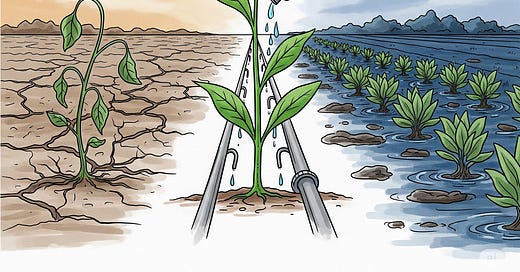The Impact of Climate Change on Irrigation Strategies
How a Warming World is Reshaping Farm Water Use
Key Impacts of Climate Change on Irrigation:
Unpredictable Rainfall: Climate change means more extreme and less predictable rainfall. Some areas get heavier, less frequent downpours leading to runoff, while others face longer, more severe dry spells. This makes it harder to rely on natural rain for crops.
Increased Temperatures & Evaporation: Rising global temperatures cause more water to evaporate from soil, plants, and water bodies. This means crops need more water to grow, even if rainfall amounts stay the same, because more moisture is lost to the air.
Longer Growing Seasons: Warmer temperatures can extend the growing season in many regions. While this might sound good for production, it also means crops need water for a longer period each year, increasing overall irrigation demand.
More Frequent Droughts and Floods: Climate change brings more intense droughts, leading to water shortages for irrigation. Conversely, more severe floods can damage irrigation infrastructure and waterlog fields, harming crops.
Reduced Water Availability: Many regions are seeing less renewable surface water and groundwater recharge due to changing precipitation and higher evaporation. This directly limits the water sources available for irrigation, especially in already water-stressed areas.
Impacts on Water Quality: Increased runoff during heavy rains can lead to more sediment and pollutants in water sources. In coastal areas, rising sea levels can cause saltwater intrusion into freshwater aquifers, making the water unsuitable for irrigation.
Adapting Irrigation Strategies for a Changing Climate:
Precision Irrigation: Using technologies like drip irrigation or smart sprinklers with sensors helps apply water directly where and when it's needed, reducing waste significantly.
Soil Moisture Monitoring: Sensors tell farmers exactly how much moisture is in the soil, preventing over-watering and ensuring efficient use of every drop.
Climate-Resilient Crop Varieties: Planting crops bred to better tolerate drought or heat can reduce their overall water needs.
Water Harvesting and Storage: Building ponds, check dams, or using rain barrels can capture and store rainwater during heavy downpours for use during dry periods.
Deficit Irrigation: Carefully applying slightly less water than the crop's full need at non-critical stages can save water without significant yield loss, but it requires careful management.
Improved Infrastructure Maintenance: Regularly checking and repairing leaky pipes, pumps, and hoses can prevent significant water loss in irrigation systems.
Weather Forecasting Integration: Using advanced weather forecasts helps farmers make informed decisions about when to irrigate, avoiding watering before rain or during periods of high evaporation.
Conclusion: Cultivating Resilience in the Face of Change
The impacts of climate change on irrigation are clear, but farmers are not powerless. By understanding these challenges and embracing adaptive strategies, we can build more resilient agricultural systems. Smart water management is key to ensuring food security and sustainable farming in a warming world.
What steps are you taking on your farm to adapt your irrigation to climate change? Share your ideas and experiences!
#ClimateChange #Irrigation #FarmResilience #WaterManagement #SustainableAgriculture #DroughtAdaptation #FloodControl #SmartFarming #FarmersChat #Agriculture #VishalRajput




